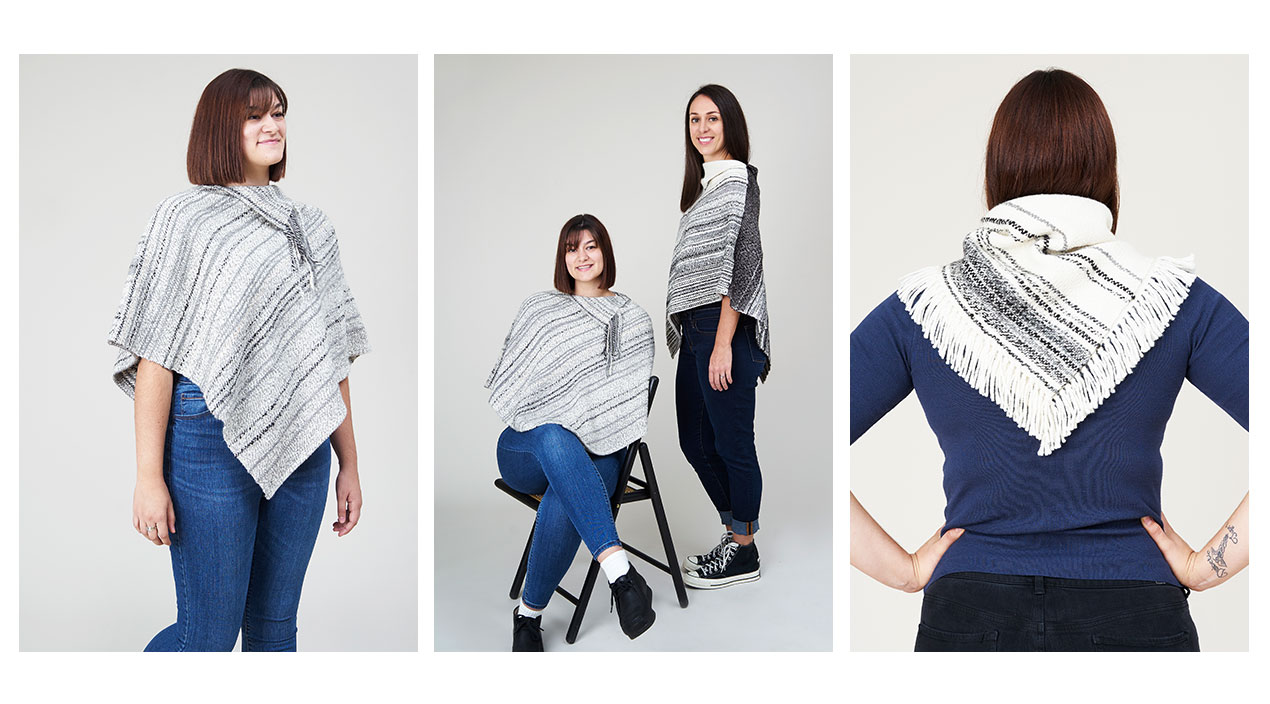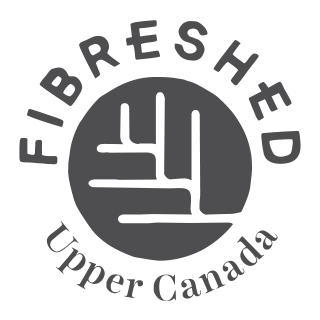In late summer, Emily and I met Dianne Kennedy-Cruttenden, a tapestry artist, weaver and dyer, at her studio in Fergus, for a chat and to see the looms. (Emily is still wondering about getting her own, and she comes close to walking out with a loom when Dianne offers a loaner.) Dianne’s studio is so colourful and bright! The walls are full of her tapestry, shelves have yarns, books and plants. Dianne settles into a loom and we talk about her work, her process and what it was like to weave something totally different in black, white and grey.

Dianne started out in pottery at Sheriden Collage in the 1970’s, but after visiting a weaving studio, she switched to weaving and apprenticed in Michigan after. “It was love at first sight. I loved the colours, the smell of the wool, the looms… all of it.”
From there Dianne has worked with several galleries and retailers on Manatoulin Island, where she lived and worked for 12 years, as well as in Fergus and Elora, where she currently resides and has studio space. Her work is driven by colour and texture preferring the natural fibres; cotton, linen, hemp and wool, and doing her own dyeing; hand painting the yarns. She approaches weaving more like a painter or sculptor, creating wearable fashions such as ponchos and scarfs that are bright and colourful, while also creating tapestries that draw you into the landscape they evoke.

“My personal style has developed over the years. The clothing is different because I came at it from a tapestry point of view, which means an artistic expression. There are two styles of weavers – the ones that are mathematical – they love the pattern weaving. That has never appealed to me.”
Dianne on the creative process:
“When I first started out in the 1970’s there was a real resurgence of fibre arts, but it was mostly tapestry weaving. They took it from tapestry to large environmental pieces. There was one woman – Magdalena Abakanowicz – I saw her work in Chicago in 1971 and just fell in love with her work. And she used big thick hemp cords and dye them, and they were bright red or brown, fabulous sculptural pieces. But they were woven. And I did a few of these pieces when I was at Sheriden because I had these big looms in the room to do this. Since I’ve been in a smaller room, I’m doing smaller pieces.”

Gail Franklin-Hawes is a textile artist and has an alpaca farm situated on 18.5 acres in Lisle, Ontario. 16.5 acres are forest, with 1.5 acres for the animals. This makes her unique among our producers. They have a managed forest plan, which includes paths for recreation and conservation practices. She is honoured to own it and considers it a gift to be able to share it.
“Farming helps you to feel alive. To work with something that is alive and to get back something from the animals. I even cried when I got my first egg! It’s truly a miracle.”

As a self-described alpaca fibre farm, they don’t breed the animals. Gail hand processes most of her own fibre, spinning it herself. She studied Material Arts at Georgian Collage, specializing in weaving and textiles. Her specialty is hand-spinning and dyeing. She also has a farm store, offers workshops, tours and open houses. In the store she has yarn, hand-spun and dyed fibre for the spinners or felters and numerous finished products.
When asked to describe a skill useful to others, time management came up as so important – as did learning how to price products as an important and powerful tool. Not to undersell the skill, time and labour involved but also understanding that charging a minimum wage for handspun yarn that took her many hours to spin, is not realistic either. It is important to know how long something took to create in order to have the whole picture of the process from start to finish. It’s difficult to convey to the consumer the effort required.

Together Dianne and Gail created two beautiful ponchos and a scarf that show off Dianne’s artistic and design abilities while showcasing Gails handspun yarn in the natural colours.
Collaborating meant playing to each other’s strengths as much as working within the bounds of the project. Dianne described working with the natural colours: “I love colour and texture. Just the last little while [since I’ve been doing this work] I’m not working with much colour, and it’s been interesting. I’ve been enjoying it. It’s good to get out of my comfort zone. My next colour is going to be red. Give me colour!”

Dianne: The process was unfamiliar – I hadn’t used 100% alpaca before – the warp was mill-spun and the weft heavier than what I usually use. Gail hand-spun all the weft. It was a learning experience I didn’t know how it would take up, as you can imagine when you’re weaving, there is a lot of intake and the warp does the same thing when you take it off the loom. It shrinks because I didn’t know what it would do because it was a learning experience, it’s always fun to learn something new. It was beautiful yarn. So soft. Amazingly soft and so warm. And I’m usually very colorful in what I weave, and this was all the natural colours, it was amazing to spend time with the natural colours, just so calming. I quite enjoyed it.

Gail – They turned out awesome – the combination of colours and how you made them unique and beautiful.
Dianne – The stripes on the design come from the weft yarn. The weaving I do in the past and fabric with clothing all the design is in the warp. So, it’s completely different. I had a totally white warp. That’s where the designs came in. It was an experiment. Gails yarn is so exquisite. It was a joy.
I love the idea that we’re here in this tiny little area and this was produced here, and isn’t that wonderful?
Shop The Collection

